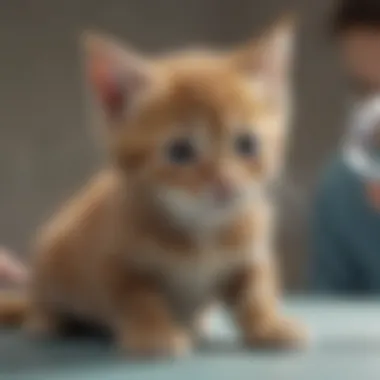Understanding Respiratory Distress in Kittens


Intro
Respiratory distress in kittens is a significant concern for pet owners and caregivers. Understanding how to recognize this condition is crucial for ensuring the well-being of these young animals. Here, we explore essential aspects such as the causes, symptoms, and the importance of prompt veterinary care. By fostering a better understanding of respiratory issues, we can enhance the chances of successful outcomes for our feline companions.
Understanding Your Pet
Breed Traits
Different cat breeds may exhibit specific health predispositions. Knowing these traits can help you anticipate potential respiratory issues. For example, flat-faced breeds like Persians and Himalayans often face breathing challenges due to their unique skull structure. Likewise, some larger breeds may be more susceptible to obesity, which can negatively impact respiratory function as they age.
Common Temperaments
Understanding your kitten's temperament can also provide insights into their health behavior. Kittens that are generally more active and playful may exhibit abnormal signs of respiratory distress more starkly compared to those that are naturally calm. Close observation of behavior changes is essential. If a previously playful kitten becomes lethargic or reluctant to engage in playful activities, it could be a warning sign of underlying health issues.
Special Needs
Kittens often have unique requirements compared to adult cats. They may need specialized care, including tailored nutrition and regular health checks, which can influence their respiratory health. Regular veterinary visits are vital for vaccinations and to monitor developmental issues that may lead to breathing difficulties.
Pet Care Essentials
Nutrition and Feeding Guidelines
Proper nutrition is vital for respiratory health. Kittens require a high-protein diet rich in essential nutrients. Ensure they have access to quality kitten food that supports their growth. Additionally, stay mindful of their weight. Obesity can lead to severe respiratory problems.
Grooming Tips and Techniques
Regular grooming helps prevent respiratory issues linked to allergens and irritants. Use appropriate brushes to remove loose fur, which can trigger allergies and breathing problems. Bathing your kitten occasionally with gentle, hypoallergenic shampoo can also ensure a clean environment.
Health and Wellness
Monitoring your kitten's health closely is crucial. Routine veterinary check-ups allow for early detection of potential respiratory problems. Pay attention to their breathing patterns. Rapid or labored breathing may indicate distress. Such symptoms demand immediate medical attention.
Training and Behavior
Basic Training Techniques
Training your kitten not only fosters better behavior but also aids in managing stress, which can impact their respiratory health. Basic commands and litter training can provide a stable environment, reducing anxiety that may affect their breathing.
Behavioral Problems and Solutions
If your kitten displays signs of distress such as hiding or excessive meowing, it may be due to underlying health concerns. Changes in behavior should be noted and discussed with a veterinarian for proper evaluation and care.
Mental Stimulation Activities
Mental enrichment is essential for kittens. Provide diverse toys and interactive games to keep their minds active. A stimulated kitten tends to be happier and less prone to stress, which can have positive effects on their overall health, including respiratory well-being.
Engaging with Your Pet
Interactive Games and Toys
Engagement through play can alleviate stress. Use feather wands or small balls to encourage activity. The interaction reassures the kitten, promoting better mental and physical health.
Safe Outdoor Activities
While outdoor activities can be stimulating, they should be approached cautiously. Always supervise your kitten outdoors. Avoid areas with high pollution or irritants that may negatively impact their respiratory health.
Family-Friendly Pet Interactions
Teaching family members how to interact appropriately with the kitten prevents stress. Gentle handling is crucial. Avoid overwhelming the kitten, allowing for a gradual integration into family life while maintaining a calm environment.
Pet Adoption and Integration
Choosing the Right Pet for Your Lifestyle
Understanding the demands of a kitten is vital before adoption. Consider your schedule and living conditions to ensure you can adequately meet their physical and emotional needs.
Preparing Your Home for a New Pet
Create a welcoming environment for your new kitten. Designate a quiet area for them to explore, ensuring safe space away from potential hazards. Remove accessible cords and toxic plants that may endanger their health.
Tips for Smooth Intro
Introducing a new kitten to existing pets requires careful planning. Allow them to meet gradually. Monitor interactions and provide separate spaces for safe exploration. Reducing anxiety for both the kitten and current pets is essential.
Remember: Prompt recognition and response to respiratory distress in kittens can make a significant difference. Stay vigilant and consult with a veterinarian for any signs of trouble.
Foreword to Respiratory Issues in Kittens
Respiratory problems can arise from various factors including infections, congenital issues, and environmental influences. Thus, comprehending these influences is essential. In this section, we will articulate key aspects of respiratory distress in kittens, its implications, and why prompt attention is necessary.
By learning about common symptoms and potential causes, pet owners can foster a proactive approach towards their kin's well-being. This awareness promotes healthier living environments, informed decisions, and ultimately contributes to better outcomes for affected kittens.
Defining Respiratory Distress
Respiratory distress in kittens refers to a condition where the animal experiences difficulty in breathing. This can manifest in various ways, such as rapid or shallow breathing, wheezing, or even gasping for air. Such symptoms indicate that the kitten may not be getting adequate oxygen, which can lead to serious health consequences.


Common terms associated with this condition include:
- Dyspnea: This is the medical term for labored or difficult breathing.
- Tachypnea: Refers to abnormally rapid breathing.
- Bradypnea: Denotes an abnormal slowness of breath.
Understanding these definitions is crucial to accurately observing signs of distress in kittens. Recognizing deviations from normal behavior is the first step toward seeking appropriate veterinary care.
Importance of Early Detection
Early detection of respiratory distress is essential for the survival and health of kittens. The sooner symptoms are identified, the quicker intervention can occur. Feline respiratory conditions can escalate rapidly, leading to severe complications if untreated.
Reasons for the urgency include:
- Rapid Deterioration: Kittens can move from mild symptoms to severe distress in a brief period.
- Underlying Conditions: Many respiratory issues are secondary to more serious health problems, like pneumonia or congenital defects.
- Mortality Risk: Delayed treatment can significantly raise the risk of mortality.
Timely intervention is critical. By recognizing symptoms and seeking veterinary help early, pet owners can drastically improve prognosis and recovery chances.
Common Symptoms of Breathing Difficulties
Recognizing common symptoms of breathing difficulties in kittens is crucial for pet owners. Early identification of respiratory problems can lead to timely veterinary intervention and improved outcomes. As kittens are still developing, they may exhibit subtle signs of distress that can escalate rapidly if ignored. Understanding these symptoms not only helps in ensuring the well-being of your pet but also empowers owners to act decisively in emergencies.
Labored Breathing
Labored breathing in kittens is a critical symptom that should not be overlooked. This condition, also known as dyspnea, indicates that a kitten is struggling to breathe, which may arise from various underlying issues such as infections or allergic reactions.
When observing a kitten, signs of labored breathing include:
- Increased effort in breathing, where the kitten may visibly strain to inhale and exhale.
- Rapid breaths, often accompanied with an elevated heart rate.
- Sound changes, where breathing might become wheezy or rasping.
A kitten's normal respiratory rate should be around 20 to 30 breaths per minute at rest. If this rate significantly increases or if breathing becomes noticeably hard, it is essential to seek veterinary help quickly. This situation can deteriorate and lead to more severe complications if not managed promptly.
Coughing and Sneezing
Coughing and sneezing are among the more apparent symptoms of respiratory distress. While an occasional cough or sneeze can be normal, repetitive episodes often indicate underlying health issues. These symptoms may arise from infections, allergies, or even environmental irritants.
Key indicators include:
- Persistent coughing, especially if it is productive, meaning it produces mucus or phlegm.
- Frequent sneezing, which might be accompanied by nasal discharge.
- Accompanying signs such as lethargy, appetite loss, or fever, which heighten concern.
If coughing and sneezing occur frequently, the underlying cause must be investigated. Allergic reactions can lead to significant discomfort and may need specific treatment. Thus, monitoring these symptoms carefully is important for determining the appropriate course of action.
Change in Behavior
A noticeable change in behavior often accompanies respiratory distress in kittens. As these animals are generally spirited and active, any sudden lethargy, withdrawal, or altered playfulness may signify a health concern.
Behavioral changes to observe include:
- Reduced activity level, where the kitten is less playful and tends to rest more than usual.
- Hiding more, as discomfort may lead them to seek secluded areas for respite.
- Change in appetite, with noticeable reluctance to eat or drink, which could signal that something is physically upsetting them.
These behavioral shifts are vital clues that point to potential respiratory issues. Pet owners should take note of these changes and connect them to other symptoms for a clearer picture of the kitten’s health.
"Understanding the symptoms of respiratory distress is vital. Early action can save a kitten's life."
In summary, being alert to common symptoms such as labored breathing, coughing, sneezing, and behavioral changes can provide essential insights into a kitten's health status. Timely intervention and proactivity can help safeguard your kitten from serious health risks.
Possible Causes of Breathing Problems
Understanding the possible causes of breathing problems in kittens is crucial to addressing respiratory distress effectively. Identifying the underlying reasons can lead to timely interventions, which can prove vital for a kitten's health. Respiratory issues can arise from a range of factors, from infections to environmental influences. Recognizing and differentiating these causes allows pet owners to respond appropriately, reducing the risk of serious complications.
Infections
Infections are among the most prevalent causes of respiratory problems in kittens. They can be viral or bacterial, each having distinct characteristics. Understanding these helps in developing proper treatment protocols.
Viral Infections
Viral infections like calicivirus or feline herpesvirus can severely compromise a kitten's respiratory system. These viruses can spread quickly and often manifest with other symptoms such as fever and lethargy. A key characteristic of viral infections is their contagious nature, particularly in shelters or multi-cat households.
The main advantage of recognizing viral infections early is that prompt veterinary care can often mitigate severe symptoms and long-term effects. However, these infections may also lead to susceptible kittens developing secondary bacterial infections, complicating their health further.
Bacterial Infections
Bacterial infections are also significant contributors to respiratory distress. Conditions like pneumonia, often initiated by bacterial agents, can rapidly escalate the seriousness of a kitten's health. A key aspect of bacterial infections is that they can arise as secondary infections following a viral illness.
The advantage of identifying a bacterial infection is that it usually responds well to specific antibiotics, offering a clear treatment path. However, if not treated quickly, such infections can cause lasting damage to lung tissue.
Allergies
Allergies in kittens can manifest as respiratory issues, often triggered by environmental factors such as pollen, dust, or certain foods. While allergies may cause itchy skin or gastrointestinal problems, their impact on breathing can be serious. Understanding the role of allergies helps in tailoring a kitten's environment to minimize these potential triggers, enhancing overall respiratory health. Being aware of allergies allows pet owners to investigate further and consult veterinarians for diagnosis and management solutions.
Congenital Issues
Congenital issues refer to structural problems present at birth that can impact a kitten's ability to breathe correctly. Supportive care and prompt veterinary intervention are essential in these cases. Identifying these issues early can greatly improve a kitten's quality of life. Owners should monitor for any unusual facial structures or signs of trouble in breathing.
Environmental Factors
Environmental factors play a significant role in respiratory health. A calming and healthy living space makes a substantial difference in preventing issues.


Aerosols and Fumes
Exposure to aerosols or fumes can lead to serious breathing difficulties. Common household products, such as cleaning agents or air fresheners, can trigger a harmful response. Awareness of these substances is vital. Keeping the home well-ventilated and using safer cleaning products can help protect kittens from respiratory problems.
Temperature Extremes
Extreme temperatures, whether hot or cold, can negatively affect a kitten's ability to breathe comfortably. Chilling winds or intense heat can lead to distress signals. Understanding how temperature affects breathing can guide owners in providing a suitable environment for their pet.
In summary, paying close attention to the possible causes of respiratory distress in kittens promotes better prevention strategies and quicker responses to symptoms, ultimately improving the health and well-being of these vulnerable animals.
When to Seek Veterinary Assistance
Understanding when to seek veterinary assistance is crucial in addressing respiratory distress in kittens. Early intervention can make a significant difference in a kitten's recovery. Kittens are especially vulnerable due to their small size and developing immune systems. Thus, knowing the signs that indicate an emergency is vital for pet owners.
Identifying Emergencies
Recognizing the signs of an emergency is the first step to ensuring your kitten receives timely care. Some clear indicators include:
- Severe difficulty breathing: This can present as wheezing or gasping.
- Cyanosis: A bluish discoloration of the lips or gums signals low oxygen levels.
- Persistent coughing or gagging: If your kitten is unable to stop coughing, this could indicate something serious.
- Lethargy or collapse: A sudden drop in energy levels is concerning and may require immediate attention.
If your kitten shows any of these symptoms, do not hesitate—contact your veterinarian right away.
Prompt Action Steps
Taking prompt action can greatly affect the outcome for your kitten. Here are essential steps to follow when you identify a respiratory emergency:
Calming the Kitten
Calming a distressed kitten is crucial. Stress can exacerbate breathing issues. Keeping your kitten calm helps to stabilize their condition. Some key characteristics of this approach include:
- Gentle handling: Speak softly and avoid sudden movements.
- Comforting environment: Create a quiet space free from loud noises or other pets.
This method is popular because it helps to lower anxiety levels, potentially enhancing oxygen flow. A unique feature of this approach is that it can be easily implemented by any pet owner, making it accessible. The advantage is that it creates a more positive environment for treatment.
Transporting to the Vet
Transporting a kitten to the vet requires careful consideration. Proper methods can minimize stress and risk to the kitten’s health. Some key aspects of this include:
- Using a secure carrier: Make sure the carrier is well-ventilated and comfortable.
- Supporting the kitten during transport: Keep the carrier stable to prevent jostling.
This approach is beneficial because it ensures that your kitten can be safely moved without additional trauma. The unique feature here is the emphasis on a stable and comforting transport method. The advantage of this method is that it enables quick access to veterinary help when time is of the essence.
"For kittens struggling with respiratory distress, understanding when to act can save lives."
Diagnosis of Respiratory Distress
Diagnosing respiratory distress in kittens is crucial for effective treatment. Kittens are particularly vulnerable to breathing issues due to their small size and developing lungs. Understanding how to identify these problems early can be the difference between life and death. Veterinary interventions can significantly improve health outcomes when symptoms are recognized promptly. This section outlines the essential assessment steps needed to diagnose respiratory difficulties in these young felines.
Initial Veterinary Examination
During the first veterinary visit, the examination plays a vital role in identifying respiratory distress. Vets will assess the kitten's overall health through a physical examination. They will look for signs such as rapid breathing, abnormal sounds, or any visible exertion while the kitten breathes. Precise observation during this initial visit sets the groundwork for further diagnostic efforts. Having a thorough understanding of the kitten's medical history and the context surrounding the symptoms can assist the veterinarian greatly.
Veterinarians often rely on observations from pet owners. Information about the kitten's environment, recent activities, and any notable behavioral changes can influence diagnosis. Owners should prepare to provide detailed background info, which includes:
- The duration and severity of symptoms
- Changes in appetite or play behavior
- Exposure to coughing or sick animals
These factors help the veterinarian build a comprehensive picture necessary for accurate diagnosis.
Diagnostic Tests
When the initial examination indicates potential issues, specific diagnostic tests are often required to ascertain the cause and severity of the respiratory distress. Two primary methods used in diagnostic evaluation are X-rays and blood tests.
X-rays
X-rays serve as a valuable diagnostic tool in determining the state of a kitten's respiratory system. By taking images of the chest cavity, veterinarians can get insights into lung condition, heart size, and structural abnormalities. The key characteristic of X-rays is their ability to reveal internal issues that may not be visible externally. This practical method is widely accepted for diagnosing among vets.
One unique advantage of using X-rays is their ability to detect fluid buildup in the lungs or signs of infection. However, a disadvantage is that this method exposes the kittens to a small amount of radiation, which demands careful consideration. Still, the benefits of rapid diagnosis often outweigh the risks. Early identification can be crucial for starting appropriate treatment for respiratory distress.
Blood Tests
Blood tests provide critical information regarding the kitten's overall health and can be instrumental in diagnosing the cause of respiratory distress. By analyzing a sample of blood, veterinarians can evaluate the kitten's immune response and detect any underlying infections or inflammation. This method is beneficial because it gives insights into both respiratory and non-respiratory conditions that could impact breathing.
Unique features of blood tests include their ability to show viral or bacterial infections and assess whether the kitten is anemic. This information guides vets in determining the course of action necessary. Although this procedure can require sedation in some young kittens, it generally represents a low-risk choice that delivers valuable results.
As pet owners, understanding the role of diagnostic testing is essential for making informed decisions about the kitten's health. Thorough examinations and appropriate tests foster a quicker return to health and comfort.
Treatment Options for Ailing Kittens
Treating respiratory distress in kittens is a vital aspect of ensuring their health and wellbeing. When a kitten is facing breathing difficulties, prompt and effective interventions can make a significant difference in their recovery. Various treatment options are available, tailored to the specific needs of the kitten based on the underlying cause of their respiratory issues. This section will focus on the two main treatment categories: medications and supportive care, which are essential for managing respiratory distress.
Medications
Medications play a crucial role in treating kittens experiencing respiratory problems. The type of medication used will typically depend on the specific diagnosis made by a veterinarian. Common categories include antibiotics for bacterial infections and antivirals for viral infections. Anti-inflammatories may also be prescribed to reduce swelling in the airways.
The effectiveness of medications lies in their ability to target the underlying cause of respiratory distress. For example, if an infection is the culprit, proper antibiotic therapy can lead to significant improvement in the kitten's condition. Therefore, it is essential to follow the veterinarian’s guidance regarding dosage and duration to ensure proper treatment.


Supportive Care
Supportive care is an integral part of the treatment process for respiratory distress in kittens. This type of care encompasses strategies that aim to comfort and stabilize a kitten while the primary treatment is being administered. Supportive care can include various methods, such as ensuring a stress-free environment and providing proper hydration and nutrition to aid recovery.
Oxygen Therapy
Oxygen therapy is one specific supportive care technique used when kittens experience severe respiratory distress. This therapy involves delivering supplemental oxygen through various methods, such as nasal cannulas or oxygen cages. The key characteristic of oxygen therapy is its ability to improve the oxygen saturation levels in a kitten's blood, especially when they are struggling to breathe effectively.
Oxygen therapy is widely recognized as a beneficial choice in cases of severe respiratory distress because it can quickly alleviate the symptoms. The unique feature of this treatment is that it can be tailored to the needs of the kitten, accommodating various levels of respiratory distress.
Despite its advantages, there are some considerations to keep in mind. Continuous monitoring is often required to ensure that the kitten responds positively to the therapy. Some kittens may experience stress from the apparatus used for oxygen delivery, which can complicate the treatment process.
Nutritional Support
Nutritional support is another important aspect of supportive care. A well-balanced diet can help strengthen a kitten's immune system and support overall health, which is especially crucial during recovery from respiratory distress. The key characteristic of nutritional support is its focus on providing the right calories and nutrients that aid in recovery.
Nutritional support is popular because it helps kittens maintain their strength and energy levels during treatment. This approach can include high-protein, easily digestible foods that promote healing. A unique feature of nutritional support is its role in encouraging kittens to eat, which can sometimes be challenging during illness.
Challenges include ensuring that the kitten consumes enough food and fluids, especially if the respiratory distress affects their appetite. Close observation and, if necessary, the use of feeding tubes may be warranted to ensure proper nutrition during recovery.
In summary, both medications and supportive care are essential for treating respiratory distress in kittens. Selecting the appropriate treatment requires guidance from a veterinarian, as they can tailor the approach to the specific needs of the kitten.
Preventative Measures for Respiratory Health
Respiratory health in kittens is crucial for their overall wellbeing. Taking preventative measures can significantly reduce the likelihood of respiratory distress.
These measures are not just beneficial for young cats but also provide peace of mind to pet owners. By understanding and implementing these strategies, one can promote a healthier environment for kittens.
Vaccination Importance
Vaccinating kittens against common respiratory diseases is critical. Vaccinations help prevent infections from viruses such as calicivirus and feline herpesvirus. These infections often lead to serious respiratory issues. By ensuring vaccinations are up to date, owners equip their kittens with essential immunity.
Moreover, some vaccines can be delivered as combined shots, saving time and minimizing stress for both the kitten and the owner. It is advisable to have a veterinary schedule for vaccinations that aligns with age and health condition. The benefits of vaccination are significant, especially in young, developing immune systems.
Maintaining a Clean Environment
Keeping a kitten's living space clean is an essential part of respiratory health. A clean environment reduces the risk of respiratory allergens and pathogens. Pet owners should be diligent in their cleaning practices.
Regular Cleaning
Regular cleaning entails frequent changes of bedding, litter, and daily tidying of areas the kitten frequents. This practice not only keeps the environment pleasant but also minimizes the buildup of dust and allergens. It is a beneficial choice for maintaining air quality. Additionally, regular cleaning interrupts cycles of disease propagation that may affect respiratory health.
A benefit of regular cleaning is the reduction in parasite exposure. Common parasites can contribute to respiratory distress if environments are neglected.
Consequently, a clean home is not just about aesthetic purposes; it is a proactive measure to ensure the kitten has a safe place to thrive.
Avoiding Irritants
Avoiding irritants within a kitten's surroundings is another vital strategy. Common household products, such as strong cleaners or fragrances, can exacerbate respiratory issues. Ensuring use of pet-safe products greatly benefits respiratory health. A notable feature of this strategy is that it requires minimal effort with potentially large payoffs.
Keeping windows open for ventilation, when safe to do so, can help ensure fresh air circulation, reducing stagnant air that may contain harmful particles.
However, pet owners should always monitor the immediate effects of new products. The avoidance of irritants is a simple but very effective way to reduce risk and keep respiratory distress at bay.
"A proactive approach to respiratory health can lead to longer, healthier lives for kittens."
In summary, understanding preventative measures can empower pet owners to take steps towards maintaining the respiratory health of their kittens. By focusing on vaccinations, cleanliness, and minimizing irritants, owners can significantly contribute to the wellbeing of their pets.
Culmination: Caring for a Kitten's Respiratory Health
Caring for a kitten's respiratory health is crucial for their overall well-being. Respiratory distress can have serious consequences if not addressed promptly. Kittens are particularly vulnerable due to their immature immune systems, making it essential for pet owners to be vigilant.
Importance of Awareness
Understanding the signs of respiratory distress is a key element in ensuring swift action. Common symptoms like labored breathing, coughing, and behavioral changes require immediate attention. Pet owners should be aware of these signs to recognize when their kitten needs veterinary care. Identifying problems early on can prevent severe health issues and improve the prognosis.
Regular Veterinary Check-ups
Regular veterinary check-ups contribute significantly to maintaining respiratory health. Vets can provide important vaccinations that protect against viral infections and other respiratory diseases. Preventive care ensures that any potential issues are addressed before they escalate into serious conditions.
Environmental Considerations
It is also vital to maintain a clean living environment. Reducing exposure to allergens like dust and smoke can help prevent respiratory problems. Regular cleaning of the home, including the kitten's bedding, litter, and toys, minimizes irritants. Avoiding harmful aerosols and strong fragrances can further enhance the respiratory well-being of kittens.
Nutrition and Supportive Care
Providing kittens with proper nutrition plays a role in their respiratory health as well. Good nutrition supports the immune system and overall vitality. Additionally, offering a calm and supportive atmosphere helps ease stress, a known factor that can exacerbate respiratory conditions.
"Healthy kittens require proactive care to thrive, with close attention paid to their breathing health."
Culmination
In summary, caring for a kitten's respiratory health involves understanding symptoms, maintaining a clean environment, ensuring proper nutrition, and seeking regular veterinary care. Pet owners must take these actions seriously, as they can make a significant difference in the quality of life for their feline companions. By prioritizing respiratory health, owners can provide a better future for their kittens.
Resources for Further Reading
In-depth understanding of respiratory distress in kittens is essential for responsible pet ownership. Accessing the right resources enhances knowledge and empowers kitten owners to support their pets effectively. Numerous factors contribute to respiratory health, making it critical for owners to remain informed and proactive.
Veterinary Guides
Veterinary guides play a significant role in providing accurate and reliable information on kitten health. These guides usually come from trusted organizations, veterinary schools, or experts in the field. They cover various topics related to respiratory issues, including detailed descriptions of symptoms and treatment protocols. Owners can understand diagnostic criteria, recommended vaccines, and essential care tips by utilizing these resources.
- Benefits of Veterinary Guides:
- Authoritative content: Information comes from professionals who specialize in animal health.
- Structured learning: Guides systematically present information, allowing for easy comprehension.
- Updated knowledge: They often include the latest research and advances in veterinary medicine.
Online Platforms
Online platforms offer a wealth of information and community support for pet owners. Websites and forums, such as those found on Reddit or Facebook, provide platforms for discussion and shared experiences regarding kittens and their respiratory health. Users can ask questions, share stories, and offer advice based on personal encounters.
- Key Features of Online Platforms:
- Interactive community: Engage with other pet owners who can share experiences.
- Variety of viewpoints: Different opinions foster a well-rounded understanding of issues.
- Resources for emergencies: Many platforms also offer advice on immediate actions to take when a kitten shows signs of distress.
The collective insight of fellow pet owners can often provide practical knowledge that complements professional veterinary advice.



